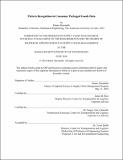| dc.description.abstract | The speed at which a manufacturing company analyzes big data and reacts to the market trends can be key to its success. In consumer packaged goods (CPG) companies, a delay in analyzing the huge amounts of data produced could result in missing opportunities to identify patterns that indicate problems, and therefore, delay response initiatives to prevent problems. This was the case with a leading CPG company that was experiencing lack of on-shelf availability of some of its profitable products. It was necessary to analyze internal data to identify where and why this problem existed. Data collection, selection and analysis were conducted over the inventory data and sales data of a leading brand at a large retail partner. This analysis enabled us to identify patterns in inventory records, including short replenishments cycles and frequency of out of stocks. It was significant that, during a few months following product introduction, there was a high frequency of out of stocks. This reduces the product’s availability on the retailer’s shelf; hence, the service level drops. A few months later, replenishment policies of some products were changed to maintain their inventory above safety level. Upon pattern identification, we provided observations on which specific stock keeping units (SKUs) and distribution centers (DCs) experienced the biggest issues. These observations could potentially be leveraged to reduce out of stocks earlier, increase on-shelf availability and improve performance in retail. | en_US |
